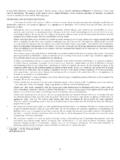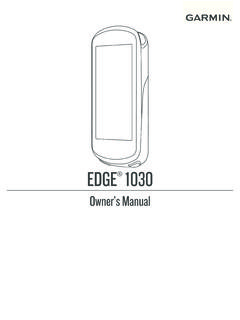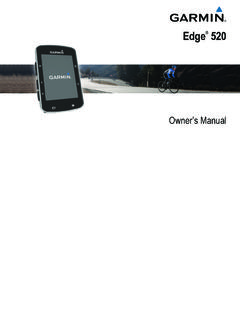Transcription of Owner s Manual - Motobecane
1 Owner s ManualMulti-Speed Bicycles23 Owner s Manualfor multi-speed bicycles6th EditionIMPORTANT:This Manual contains important safety, performanceand service it before you take the first ride on your new bicycle,and keep it for pageGENERAL special note to FirstA. Bike Safety Mechanical Safety First SafetyA. The Riding Off Road Wet Weather Night Downhill or Competition Changing Components or Adding FitA. Standover Saddle Handlebar height and Control Position Brake TechA. Wheel Quick Removing and Installing Quick Release Removing and Installing Bolt-On Seatpost Quick Shifting Bicycle Tires and ServiceA. Service If your bycicle sustains an : This Manual is not intended as a comprehensive use,service, repair or maintenance Manual . Please see yourdealer for all service, repairs or maintenance. Your dealermay also be able to refer you to classes,clinics or bookson bicycle use, service, repair or WARNING :Like any sport, bicycling involves risk of injury and damage.
2 By choosing to ride a bicycle,you assume the responsibilityfor that risk, so you need to know and to practice the rules of safe and responsible riding and of proper use andmaintenance. Proper use and maintenance of your bicycle reduces risk of Manual contains many Warnings and Cautions concerning the consequences of failure to maintain or inspectyour bicycle and of failure to follow safe cycling practices. The combination of the safety alert symbol and the wordWARNING indicates a potentially hazardous situationwhich, if not avoided, could result in serious injury or death. The combination of the safety alert symbol and the wordCAUTION indicates a potentially hazardous situationwhich, if not avoided, may result in minor or moderate injury, or is an alert against unsafe practices. The wordCAUTION used without the safety alert symbol indicates a situation which, if not avoided, could result inserious damage to the bicycle or the voiding of your of the Warnings and Cautions say you may lose control and fall.
3 Because any fall can result in serious injury oreven death, we do not always repeat the warning of possible injury or it is impossible to anticipate every situation or condition which can occur while riding, this Manual makes norepresentation about the safe use of the bicycle under all conditions. There are risks associated with the use of any bicyclewhich cannot be predicted or avoided, and which are the sole responsibility of the rider.!!7A special note for parents:As a parent or guardian, you are responsible for the activities and safety of your minor child, and thatincludes making sure that the bicycle is properly fitted to the child; that it is in good repair and safe operatingcondition; that you and your child have learned and understand the safe operation of the bicycle; and thatyou and your child have learned, understand and obey not only the applicable local motor vehicle, bicycleand traffic laws, but also the common sense rules of safe and responsible bicycling.
4 As a parent, you shouldread this Manual , as well as review its warnings and the bicycle s functions and operating procedures withyour child, before letting your child ride the : Make sure that your child always wears an approved bicycle helmet when riding; but also make sure that your child understands that a bicycle helmet is for bicycling only, and must be removedwhen not riding. A helmet must not be worn while playing, in play areas, on playground equipment, whileclimbing trees, or at any time while not riding a bicycle. Failure to follow this warning could result in seriousinjury or death.!81. FirstNOTE: We strongly urge you to read this Manual in its entiretybe-fore your first ride; but at the very least, read and make sure thatyou understand each point in this section, and refer to the citedsections on any issue which you don t completely Bike fit1. Is your bike the right size?
5 To check, see yourbicycle is too large or too small for you, you may lose control andfall. If your new bike is not the right size, ask your dealer toexchange it before you ride Is the saddle at the right height? To check, see Ifyou adjust your saddle height, make sure that you follow theMinimum Insertion instructions in Section Are saddle and seatpost securely clamped? A correctlytightened saddle will allow no saddle movement in any for Are the stem and handlebars at the right height for you? Ifnot, see Section on what you can do about Can you comfortably operate the brakes? If not, you maybe able to adjust their angle and reach. See Section and Do you fully understand how to operate your new bicycle? Ifnot,before your first ride, have your dealer explain any functionsor features which you do not Safety first1. Always wear an approved helmet when riding your bike,and follow the helmet manufacturer s instructions for fit, use andcare of your Do you have all the other required and recommendedsafety equipment?
6 See Section 2. It s your responsibility tofamiliarize yourself with the laws of the areas where you ride, andto comply with all applicable Do you know how to correctly operate your wheel quickreleases? Check Section to make sure. Riding with animproperly adjusted wheel quick release can cause the wheel towobble or disengage from the bicycle, and cause serious injury If your bike has toeclips and straps or clipless ( step-in )pedals, make sure you know how they work (see Section ).These pedals require special techniques and skills. Follow thepedal manufacturer s instructions for use, adjustment and Does your bike have suspension? If so, check Section can change the way a bicycle performs. Follow thesuspension manufacturer s instructions for use, adjustment Do you have toe overlap ? On smaller framed bicycles yourtoe or toeclip may be able to contact the front wheel when apedal is all the way forward and the wheel is turned.
7 See Mechanical Safety CheckRoutinely check the condition of your bicycle before every , bolts & straps: Make sure nothing is loose. Lift the frontwheel off the ground by two or three inches, then let it bounce onthe ground. Anything sound, feel or look loose? Do a quick visualand tactile inspection of the whole bike. Any loose parts oraccessories? If so, secure them. If you re not sure, ask someonewith experience to & Wheels: Make sure tires are correctly inflated (seeSection ). Check by putting one hand on the saddle, one onthe intersection of the handlebars and stem, then bouncing yourweight on the bike while looking at tire deflection. Compare whatyou see with how it looks when youknow the tires are correctlyinflated; and adjust if in good shape? Spin each wheel slowly and look for cutsin the tread and sidewall. Replace damaged tires before ridingthe true? Spin each wheel and check for brakeclearance and side-to-side wobble.
8 If a wheel wobbles side to sideeven slightly, or rubs against or hits the brake pads, take the biketo a qualified bike shop to have the wheel : Wheels must be true for the brakes to work truing is a skill which requires special tools and experience. Donot attempt to true a wheel unless you have the knowledge, experienceand tools needed to do the job : Check the brakes for proper operation (see ). Squeeze the brake levers. Are the brake quick-releasesclosed? All control cables seated and securely engaged? Do thebrake pads touch the wheel rim within an inch of brake levermovement? Can you apply full braking force at the levers withouthaving them touch the handlebar? If not, your brakes not ride the bike until the brakes are Releases: Make sure the front wheel, rear wheel andseat post quick releases are properly adjusted and in the lockedposition. See Section and and saddle alignment: Make sure the saddle andhandlebar stem are parallel to the bike s center line and clampedtight enough so that you can t twist them out of alignment.
9 SeeSections and If not, align and tighten ends: Make sure the handlebar grips are secureand in good condition. If not, replace them. Make sure thehandlebar ends and extensions are plugged. If not, plug thembefore you ride. If the handlebars have bar end extensions, makesure they are clamped tight enough so you can t twist them. If not,tighten : Loose or damaged handlebar grips or extensions can causeyou to lose control and fall. Unplugged handlebars or extensions can cut yourbody and can cause serious injury in an otherwise minor accident.!!10D. First rideWhen you buckle on your helmet and go for your firstfamiliarization ride on your new bicycle, be sure to pick acontrolled environment, away from cars, other cyclists, obstaclesor other hazards. Ride to become familiar with the controls,features and performance of your new yourself with thebraking action of the bike ( ).
10 Test the brakes at slow speed, putting your weighttoward the rear and gently applying the brakes, rear brake or excessive application of the front brake could pitch youover the handlebars. Applying brakes too hard can lock up awheel, which could cause you to lose control and your bicycle hastoeclips orclipless pedals, practice gettingin and out of the pedals. See paragraph your bike hassuspension, familiarize yourself with how thesuspension responds to brake application and rider weight paragraph above and Section the gears (see Section ).Remember to never move the shifter while pedaling backward,nor pedal backwards after having moved the shifter. This couldjam the chain and cause serious damage to the bicycle and maycause you to lose control and out the handling and response of the bike; and checkthe you have any questions, or if you feel anything about thebike is not as it should be, take the bike back to your dealer SafetyA.



